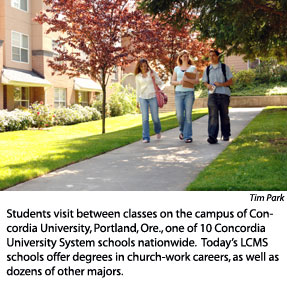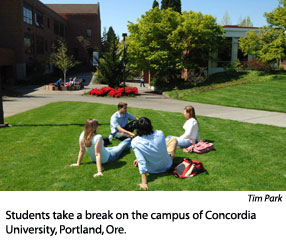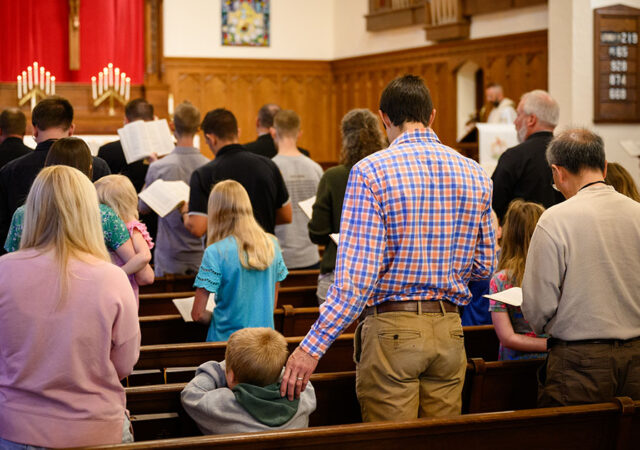By D. Ray Halm
I leaned my Schwinn against the side of the house and click-clacked my way to the door. As I sat on the sill between the back porch and the kitche n unlacing my baseball spikes, my mother asked how the game turned out.
n unlacing my baseball spikes, my mother asked how the game turned out.
“I sat on the bench the entire game,” I explained, feeling sorry for myself and trying my best to coax sympathy from Mom.
“Dennis,” she said, “if you were Mormon like the other boys, things would be different. You know that’s true.” This was a mother doing her best to help her son handle the trials of growing up playing Pony League baseball in Provo, Utah, where in the 1950s nine out of 10 residents were Latter Day Saints.
Three years later my parents began to talk of sending me to a not-too-distant Presbyterian boarding school for my high school (and dating) years. When our new pastor at St. Mark’s Lutheran Church heard of my family’s desire, he recommended a Lutheran boarding high school 1,000 miles away in Seward, Neb.
So that’s where I went in September of 1956 — 50 years ago — and I have been in love with Lutheran schools ever since.
The high school department at Concordia University–Nebraska was closed in 1972. Identical high schools also were closed before and after Seward on the campuses of Bronxville, N.Y.; River Forest, Ill.; St. Paul, Minn.; Austin, Texas; Milwaukee; Portland, Ore.; and Oakland, Calif. It is simply a fact of life that educational practices change and the schools of The Lutheran Church–Missouri Synod adapt to the trends.
were closed before and after Seward on the campuses of Bronxville, N.Y.; River Forest, Ill.; St. Paul, Minn.; Austin, Texas; Milwaukee; Portland, Ore.; and Oakland, Calif. It is simply a fact of life that educational practices change and the schools of The Lutheran Church–Missouri Synod adapt to the trends.
So it is no surprise that reorganization of the Synod’s collegiate programs has continued to occur in response to societal pressure. Examples would include modification of the traditional four-year teacher education degree to a five-year program in response to legislation in some of our states, closure of the junior-college programs followed by an increase in the number of baccalaureate campuses, and the list goes on.
In 1956 a young Lutheran woman could aspire to nursing, teaching, or a secretarial position with little else to consider. Today’s college woman has myriad options in which to express her love for the Lord and His Church.
Nor could a young man or woman consider being a director of Christian education (DCE) or a director of Christian outreach (DCO) in 1956. But how fortunate  that we have our own LCMS universities where we can adjust our academic programs to meet the challenges of ministry in a rapidly changing, constantly shifting world.
that we have our own LCMS universities where we can adjust our academic programs to meet the challenges of ministry in a rapidly changing, constantly shifting world.
Our beloved Concordias have adapted well to change where necessary and will continue to do so, while simultaneously all of them have remained ever faithful to the mission of the Synod.
Today my own students at CUEnet (Concordia University Education Network) are state college graduates who teach in a Lutheran school and who, like their counterparts of decades past, yearn to integrate the faith, doctrine, and practice of the Synod into their classroom teaching of the arts and sciences. They are enrolled in our Synod’s colloquy program.
The difference is that my students and I now gather together online. But it’s the same wonderful LCMS education I first encountered in 1956. The doctrine I teach is the same doctrine I learned so long ago.
If memory serves, the first time I heard talk of the LCMS school system being absolutely unique in American Christendom was that first year as a high school sophomore at Seward. But 50 years of service as a teacher, pastor, and university president in the Synod have confirmed the fact. Our schools — elementary through university and seminary — were and are shining jewels in American education.
One of the concerns I hear expressed about LCMS higher education from time to time is that the number of students preparing to serve the church has declined. On this matter some perspective is required.
First of all, it is my impression that the LCMS has more students preparing for church work per 1,000 congregation members than any denomination in the United States. Yet, while this may be encouraging, we must acknowledge that our raw number of students in college who are enrolled in programs specific to full-time service in congregations is down.
To properly understand this phenomenon, a second perspective is critical. Today’s young men and women not only remain single longer than we did in my generation, but today’s college-age student also wants more time to finalize a career choice. Delayed choice helps to explain why the average age among America’s college population has increased, and it accounts, at least in part, for the lower number of students on our campuses who are officially registered in church-work programs.
The good news is that despite all such trends, our schools remain vibrant institutions which year after year provide the servants needed to preach the Word and teach the children.
In closing, let me share with you that I loved that boarding high school in Seward in 1956 — I loved it more than any other school I ever attended. But I sat on the bench there, too.
Dr. D. Ray Halm is a former Lutheran high school teacher and principal, and served as president of Concordia University, Irvine, Calif., from 1980 to 1998. He is now senior director of the Synod’s CUEnet program.
Posted Dec. 28, 2006




